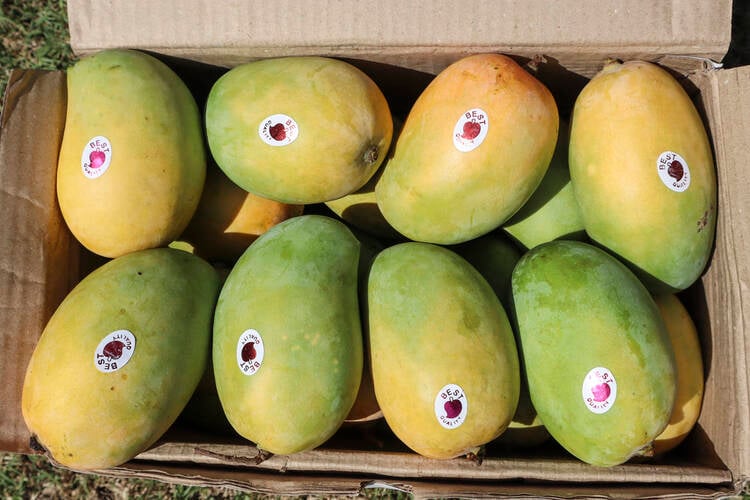
You should plan for a startup budget above $150,000 to properly set up your mango export business.
Note that this figure could be lower or higher depending on your location, scale of operation, and target market.
Therefore, you should have a robust budget that covers key expenses such as sourcing quality mangoes, packaging, transportation, storage, quality control, export documentation, and compliance with international trade regulations.
You may also need to invest in certifications, international marketing, and building relationships with buyers abroad.
Factors that Determine the Income of a Mango Export Business
-
Sourcing and Procurement of Mangoes
The cost of sourcing mangoes can vary significantly based on the variety, quality, and region you’re buying from.
Premium mango varieties like Alphonso or Kent command higher prices due to their flavor, size, and shelf life.
You will also need to consider the cost of visiting farms, negotiating with growers, and arranging contracts.
Buying during peak seasons may lower costs, but you will still need to plan for fluctuations in availability and pricing.
You may also want to consider investing in relationships with reliable suppliers to ensure consistent quality.
-
Packaging and Grading Equipment
Proper packaging is essential to protect mangoes during transit and meet international standards.
This includes cartons, crates, foam nets, ventilation liners, and sometimes refrigeration-ready packaging.
You may also need equipment for washing, grading, and sorting mangoes by size and quality.
Investing in quality packaging materials and machines ensures your products arrive in excellent condition.
If you’re exporting large volumes, semi-automated or automated grading and packaging lines may be necessary, significantly increasing your startup costs.
-
Storage and Cold Chain Facilities
Mangoes are perishable and require proper post-harvest handling and storage. Cold storage facilities help extend shelf life and preserve fruit quality, especially if there’s a delay between harvest and export. Renting space in a cold room or investing in your own refrigerated storage can be costly.
The more volume you handle, the larger the facility you will need. You may also incur utility costs for maintaining low temperatures. Without proper cold chain infrastructure, there’s a higher risk of spoilage, which translates to losses.
-
Export Licenses and Compliance Costs
Exporting mangoes requires compliance with local and international regulations. You will need an export license, phytosanitary certificates, and possibly Global GAP or organic certifications, depending on your target market. Each certificate or permit has associated costs and may require audits, inspections, or product testing.
Regulations vary by country, so understanding the requirements of your destination markets, such as the U.S., EU, or Middle East, is important. Legal consultation fees, certification renewals, and compliance training for your staff should also be part of your startup budget.
-
Transportation and Logistics
Transporting mangoes from farms to packaging facilities and then to ports or airports involves significant cost. You will need to arrange for trucks with proper ventilation or cooling, especially in hot climates. International shipping by air for faster delivery or by sea for bulk transport adds to your expenses.
Air freight is costlier but reduces spoilage risk, while sea freight is economical but slower. Logistics costs also include customs clearance, warehousing, container handling, and possibly hiring freight forwarders. Delays or mishandling at any stage can lead to spoilage, so investing in reliable logistics partners is essential to avoid losses.
-
Marketing and Branding
Building a recognizable brand in the international mango market takes time and money. Marketing expenses may include logo design, packaging branding, website development, product photography, and promotional campaigns. You will also need to attend international trade shows, create samples for prospective buyers, and maintain an online presence through social media and export platforms.
Paid advertising, whether digital or print, further boosts brand visibility. Strong branding not only helps you command higher prices but also builds trust and loyalty among overseas buyers.
-
Business Registration and Legal Fees
Before you start exporting, you must legally register your business with the appropriate authorities in your country. This includes obtaining a business license, tax identification number, and possibly registering as an exporter with a national trade authority.
Legal fees may be involved if you hire professionals to help you draft contracts, negotiate deals, or set up legal entities in other countries. Depending on your country, the cost of these administrative processes can vary. Ignoring legal formalities can result in delays, penalties, or denial of export privileges.
-
Quality Control and Inspection
Maintaining high-quality standards is very important in mango export, as international markets are strict about pesticide levels, ripeness, size uniformity, and absence of physical damage. You may need to hire trained inspectors or work with third-party agencies to conduct quality assessments and provide inspection reports.
These inspections help ensure that only export-grade fruits are shipped, reducing the risk of returns or reputational damage. Some countries may require pre-shipment inspection certificates from authorized bodies.
-
Insurance and Risk Management
Exporting agricultural goods like mangoes involves risks such as spoilage, damage in transit, delays, theft, or rejection at the destination port. To protect against these risks, you will need different types of insurance, such as cargo insurance, business liability insurance, and product liability insurance.
While premiums vary depending on the volume and destination, insurance offers peace of mind and financial protection in the event of unexpected losses. You may also need legal consultation for risk assessment and to develop a mitigation plan.
-
Scale of Operation
Lastly, the size and scale of your mango export business will greatly influence your startup costs. A small-scale operation focused on one export market and seasonal shipments will require significantly less capital than a large-scale business targeting multiple countries with year-round exports.
Large-scale operations demand higher volumes of inventory, larger staff, more equipment, and expansive marketing strategies. While scaling up can lead to economies of scale and greater profits, it also involves higher initial investment and risk. Carefully determining your capacity and growth plan will help you budget realistically and allocate resources wisely from the start.
